Stuck heads fore WiFi equipment manufacturers. (I apologize wildly, but Ruckus did everyone again)
CARNet Research Center, specializing in the use of IT technologies in the field of education, conducted testing of WiFi access points of famous manufacturers. We give them in alphabetical order: Aerohive, Aruba, Cisco, HP, Meraki, Ruckus , Ubiquiti, Xirrus. The tests were carried out according to the method of power extreme - each new approach was accompanied by an increased load. Not all survived. A little more about the experiment.
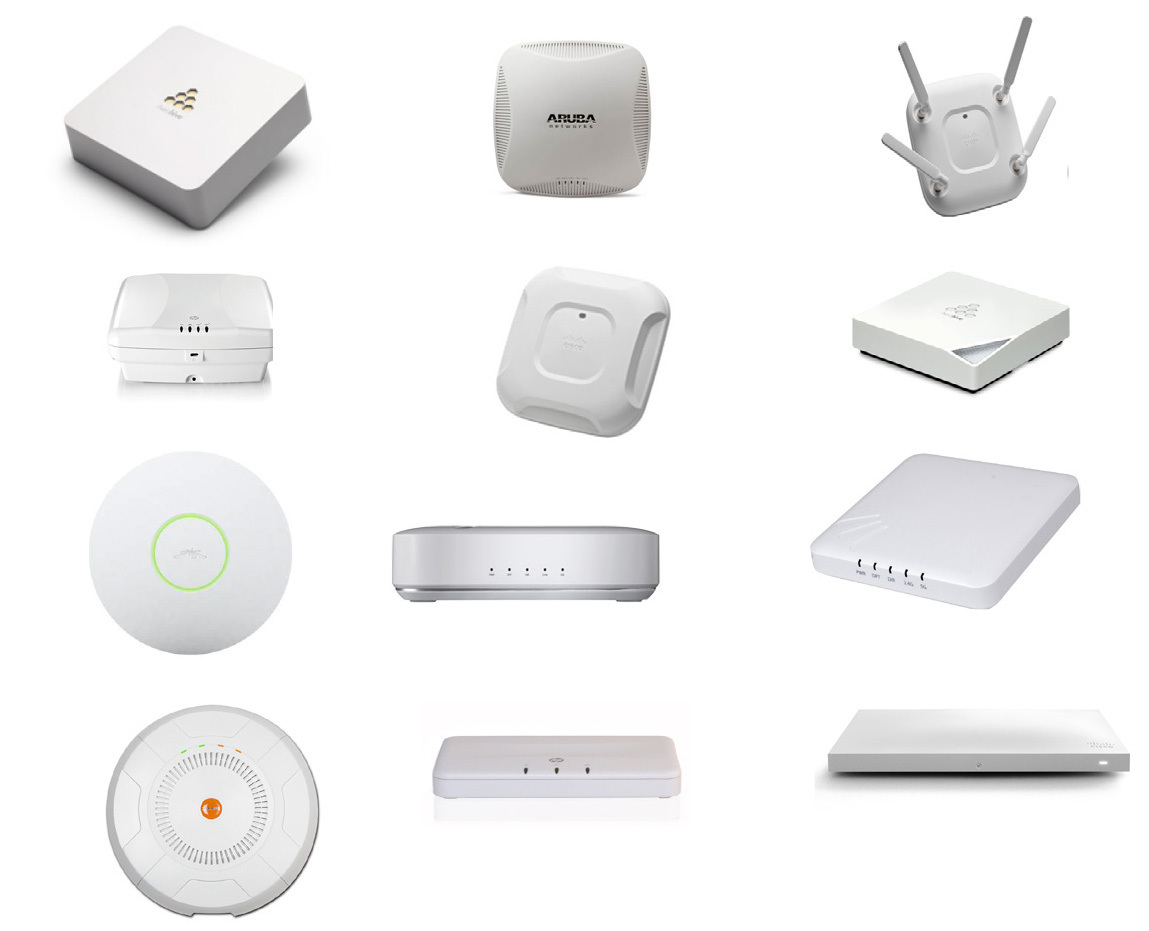
The standard audience size of 10 x 12 meters was gradually filled with WiFi clients - subscribers with laptops and tablets from four manufacturers - Samsung, Apple, HP and Lenovo. The client devices were of different models, with one or two radio modules, working in the 2.4 and 5 GHz bands, in two standards 802.11n and 802.11ac. In other words, the usual situation was created when every student comes with his own device (bring your device - BYOD).
Client Device Table

Experimental access points were located outside the room behind the plasterboard partition, which created a 5 dB attenuation.
')
First, 13 people worked in the audience, then the number of subscribers increased to 23, 36 and 60 people. At the end of the experiment, the number of devices was reduced to 36, but they were located along a 270 degree arc, which made the point work in difficult conditions of spatial separation of subscribers.
The purpose of the experiment was to find out the maximum capacity of the equipment in the direction of all tested clients. Bandwidth tests were conducted in the downstream direction. This involved transferring a 1 MB file and using the latest version of the IxChariot test suite.
Important note! The test was attended by representatives of all manufacturers. Moreover, they were not just observers - they were given the opportunity to independently test each of their access points, select the testing channel and its width, and adjust the points according to the best operating conditions in their opinion. In other words, the representative of each company was given the opportunity to verify that the equipment is functioning properly. And most importantly, experts had the opportunity to optimize the configuration of each access point to ensure the best performance.
So, the following access currents are gathered at the starting position:
Test Access Point Table
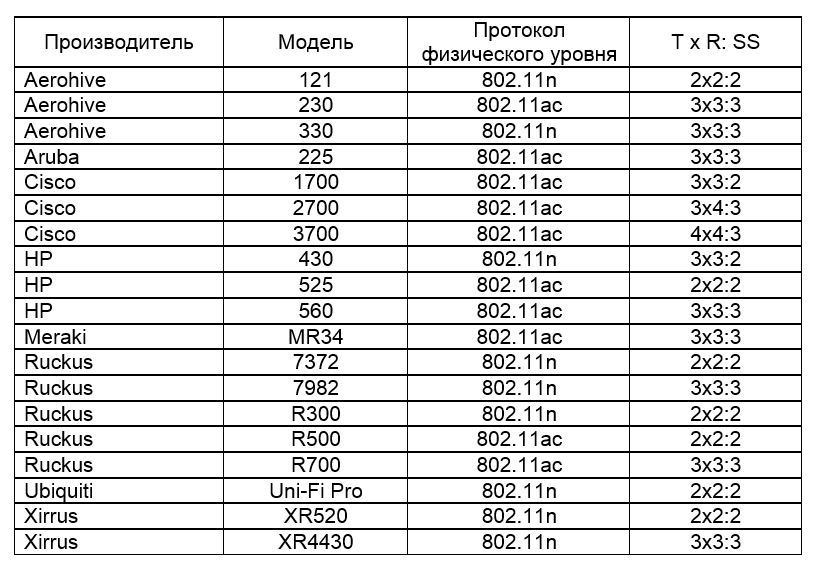
CARNet did not in any way “clean” the radio-frequency environment, since the systems actually deployed must deal with arbitrary (and often uncontrollable) levels of modulated and unmodulated interference. During testing, the stable working dual-band WiFi network of CARNet agency and 2.4 GHz motion sensors were used.

Warm up In the audience of 13 subscribers. Results:
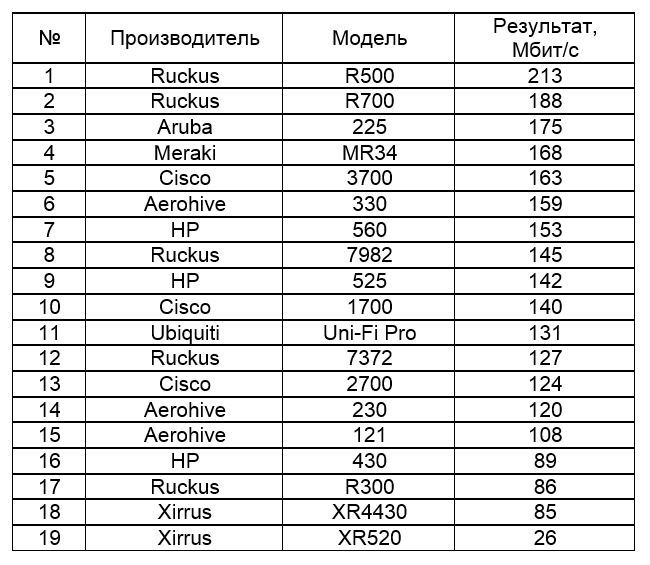
Everybody coped with the test, but the variation in the values of the first and last place is almost an order of magnitude. Note Ubiquiti - walked well with famous opponents, and Ruckus climbed to the top of the pyramid.
We add 10 more clients - only 23 devices. We look at the result:
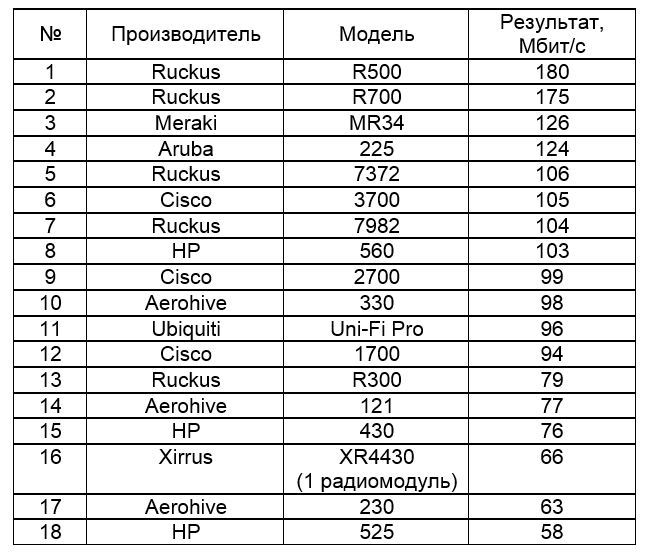
One of the Xirrus fell off, but the second is doing well. The leaders are Ruckus, Meraki, Aruba and Cisco, but 175 Mbps and 105 Mbps are two big differences.
Add another 13 clients. There are already 36 subscribers in the audience. (It seems that the second training pair has begun and half of the group has been pulled up to it. It's a joke).
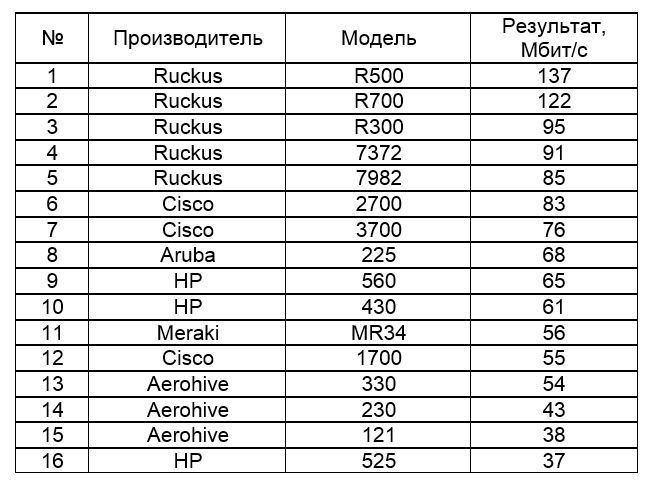
Lost Ubiquiti and the second Xirrus. We tell them thanks for the fight. And what do we see in the performance report? - Ruckus the whole team indecently occupied the entire top of the table. The small entry point level of the Ruckus R300, the size of two cigarette packs, overtook the flagship Cisco 3700. Not good. But what to do.
The climax. We conduct exams. Now all 60 subscribers in the audience. Look what happened:
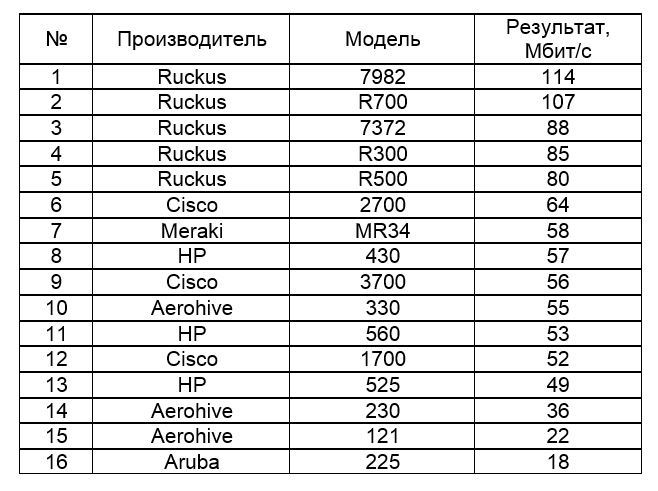
Again, everyone endured the test, no one dropped out, but what did it mean endure - again almost a tenfold gap between the leader and the outsider. Someone is already being awarded, and someone is just completing the exercises, the results of which are not interesting to anyone. Actually, award, as before Ruckus.
And the last test is no longer strength exercises, but rather a struggle without rules. The access point from three sides is surrounded by 36 subscribers.
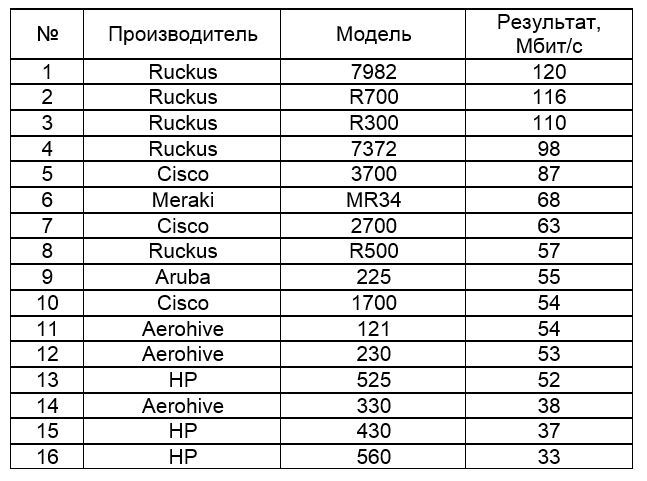
The test passed again all the points. The Cisco 3700 managed to oust the Ruckus R500, but still the entire pedestal was occupied by the Ruckus.
Let's sum up. Let’s throw away the exotic test with customers located in a 270 degree arc, leave a maximum of three points from each manufacturer and get the final graph:

So, we congratulate Ruckus on the victory and make a conclusion - in rooms where there are many subscribers, do not look at the technical characteristics stated in the description - conduct field tests, look at the devices.
At the end of cheating, take a screwdriver and open the lid of the Ruckus R700:


We see the main component of the victory - a developed antenna system.
A few words about the CARNet center. This is a public institution located in Croatia, focused on the support and provision of educational institutions in the field of information technology. The center has been operating for a quarter of a century and includes 240 academic communities and 1,400 primary and secondary schools. In total, CARNet serves more than 2.3 thousand educational institutions. More information is available at http://www.carnet.hr/en
PS If you want to test, we will be glad to help you.

The standard audience size of 10 x 12 meters was gradually filled with WiFi clients - subscribers with laptops and tablets from four manufacturers - Samsung, Apple, HP and Lenovo. The client devices were of different models, with one or two radio modules, working in the 2.4 and 5 GHz bands, in two standards 802.11n and 802.11ac. In other words, the usual situation was created when every student comes with his own device (bring your device - BYOD).
Client Device Table
Experimental access points were located outside the room behind the plasterboard partition, which created a 5 dB attenuation.
')
First, 13 people worked in the audience, then the number of subscribers increased to 23, 36 and 60 people. At the end of the experiment, the number of devices was reduced to 36, but they were located along a 270 degree arc, which made the point work in difficult conditions of spatial separation of subscribers.
The purpose of the experiment was to find out the maximum capacity of the equipment in the direction of all tested clients. Bandwidth tests were conducted in the downstream direction. This involved transferring a 1 MB file and using the latest version of the IxChariot test suite.
Important note! The test was attended by representatives of all manufacturers. Moreover, they were not just observers - they were given the opportunity to independently test each of their access points, select the testing channel and its width, and adjust the points according to the best operating conditions in their opinion. In other words, the representative of each company was given the opportunity to verify that the equipment is functioning properly. And most importantly, experts had the opportunity to optimize the configuration of each access point to ensure the best performance.
So, the following access currents are gathered at the starting position:
Test Access Point Table
CARNet did not in any way “clean” the radio-frequency environment, since the systems actually deployed must deal with arbitrary (and often uncontrollable) levels of modulated and unmodulated interference. During testing, the stable working dual-band WiFi network of CARNet agency and 2.4 GHz motion sensors were used.

Warm up In the audience of 13 subscribers. Results:
Everybody coped with the test, but the variation in the values of the first and last place is almost an order of magnitude. Note Ubiquiti - walked well with famous opponents, and Ruckus climbed to the top of the pyramid.
We add 10 more clients - only 23 devices. We look at the result:
One of the Xirrus fell off, but the second is doing well. The leaders are Ruckus, Meraki, Aruba and Cisco, but 175 Mbps and 105 Mbps are two big differences.
Add another 13 clients. There are already 36 subscribers in the audience. (It seems that the second training pair has begun and half of the group has been pulled up to it. It's a joke).
Lost Ubiquiti and the second Xirrus. We tell them thanks for the fight. And what do we see in the performance report? - Ruckus the whole team indecently occupied the entire top of the table. The small entry point level of the Ruckus R300, the size of two cigarette packs, overtook the flagship Cisco 3700. Not good. But what to do.
The climax. We conduct exams. Now all 60 subscribers in the audience. Look what happened:
Again, everyone endured the test, no one dropped out, but what did it mean endure - again almost a tenfold gap between the leader and the outsider. Someone is already being awarded, and someone is just completing the exercises, the results of which are not interesting to anyone. Actually, award, as before Ruckus.
And the last test is no longer strength exercises, but rather a struggle without rules. The access point from three sides is surrounded by 36 subscribers.
The test passed again all the points. The Cisco 3700 managed to oust the Ruckus R500, but still the entire pedestal was occupied by the Ruckus.
Let's sum up. Let’s throw away the exotic test with customers located in a 270 degree arc, leave a maximum of three points from each manufacturer and get the final graph:

So, we congratulate Ruckus on the victory and make a conclusion - in rooms where there are many subscribers, do not look at the technical characteristics stated in the description - conduct field tests, look at the devices.
At the end of cheating, take a screwdriver and open the lid of the Ruckus R700:


We see the main component of the victory - a developed antenna system.
A few words about the CARNet center. This is a public institution located in Croatia, focused on the support and provision of educational institutions in the field of information technology. The center has been operating for a quarter of a century and includes 240 academic communities and 1,400 primary and secondary schools. In total, CARNet serves more than 2.3 thousand educational institutions. More information is available at http://www.carnet.hr/en
PS If you want to test, we will be glad to help you.
Source: https://habr.com/ru/post/261361/
All Articles